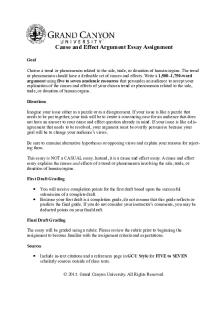ENG-106 Topic 1DQ1 - DISCUSSION PDF

| Title | ENG-106 Topic 1DQ1 - DISCUSSION |
|---|---|
| Author | Nicolee Odom |
| Course | English Composition II |
| Institution | Grand Canyon University |
| Pages | 3 |
| File Size | 195.7 KB |
| File Type | |
| Total Downloads | 13 |
| Total Views | 143 |
Summary
DISCUSSION...
Description
In the argument chapter, you learned about expressed arguments (overt arguments attempting to persuade the audience towards a point of view) and implied arguments (arguments that appear on the surface not to be arguments but actually seek to persuade the audience of a point of view or views). For this DQ, provide a specific example from the media of an expressed argument and an implied argument and answer the following questions:
What is the expressed argument you identified? What specific argument does the author make? What evidence does the author use to support his or her claims?
An example of an expressed argument that I have found in the media is an article addressed to teens about how social media affects the brain. Teens usage of the social media platform is becoming more and more every day because of the popularity gain they receive from the amount of ‘likes, comments, and shares’ from their viewers. To support their argument, researchers at UCLA’S Brain Mapping Center were utilized to study the brain responses of random teens. Quoted from an author in the article is evidence that “When teens learn that their own pictures have supposedly received a lot of likes, they show significantly greater activation in parts of the brain's reward circuitry. This is the same group of regions responding when we see pictures of a person we love or when we win money” (East 2016).
What is the implied argument you identified? What specific argument does the author make? What evidence does the author use to support his or her claims?
In this cartoon editorial, we see Trump and a few well-known make-believe monsters that were intended for us to be afraid of. At some point we called them “monsters” based on the role they played as characters, but the role some Americans play as leaders makes our point of view no different from them. It is as if the ‘pot is calling the kettle black’.
Why is it important to understand expressed and implied arguments?
Because they both have the same base word, the descriptive word gives them their distinctive meanings. One is to be used to persuade an individual onto your side of a certain discussion – expressed argument. The other is merely used to assist others in being open-minded to other options other than what is being presented but not arguing to choose a side – implied argument.
How might you use your understanding of expressed and implied arguments when drafting your first essay in this course?
By understanding these types of arguments, it will help me to control the flow and direction of my paper. I will either be choosing to persuade an audience or lay out other options and facts to ponder on. References Britt, C. (2020, October 29). See more editorial cartoons at The Week. Retrieved November 04, 2020, from https://theweek.com/cartoons/946655/political-cartoon-trump-covid-deathshalloween East, S. (2016, August 01). Teens: This is how social media affects your brain. Retrieved November 04, 2020, from https://www.cnn.com/2016/07/12/health/social-mediabrain/index.html
Note: You may use visual arguments such as photos and pictures, but you will still need to explain your rationale for why you believe the author is making a specific argument....
Similar Free PDFs

ENG-106 Topic 1DQ1 - DISCUSSION
- 3 Pages

Discussion Forum Topic 10
- 1 Pages

Discussion Topic 8
- 2 Pages

Topic 2 Discussion Question 2
- 1 Pages

Topic 6: Discussion Question 1:
- 1 Pages

Topic 6 DQ 2 - Discussion
- 1 Pages

Topic 1 Discussion Question 1
- 1 Pages

ENG106 T2 Definition Rubric
- 4 Pages
Popular Institutions
- Tinajero National High School - Annex
- Politeknik Caltex Riau
- Yokohama City University
- SGT University
- University of Al-Qadisiyah
- Divine Word College of Vigan
- Techniek College Rotterdam
- Universidade de Santiago
- Universiti Teknologi MARA Cawangan Johor Kampus Pasir Gudang
- Poltekkes Kemenkes Yogyakarta
- Baguio City National High School
- Colegio san marcos
- preparatoria uno
- Centro de Bachillerato Tecnológico Industrial y de Servicios No. 107
- Dalian Maritime University
- Quang Trung Secondary School
- Colegio Tecnológico en Informática
- Corporación Regional de Educación Superior
- Grupo CEDVA
- Dar Al Uloom University
- Centro de Estudios Preuniversitarios de la Universidad Nacional de Ingeniería
- 上智大学
- Aakash International School, Nuna Majara
- San Felipe Neri Catholic School
- Kang Chiao International School - New Taipei City
- Misamis Occidental National High School
- Institución Educativa Escuela Normal Juan Ladrilleros
- Kolehiyo ng Pantukan
- Batanes State College
- Instituto Continental
- Sekolah Menengah Kejuruan Kesehatan Kaltara (Tarakan)
- Colegio de La Inmaculada Concepcion - Cebu







